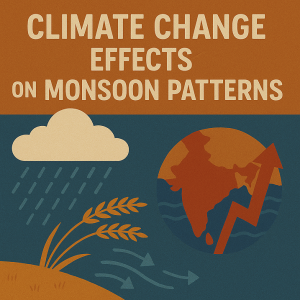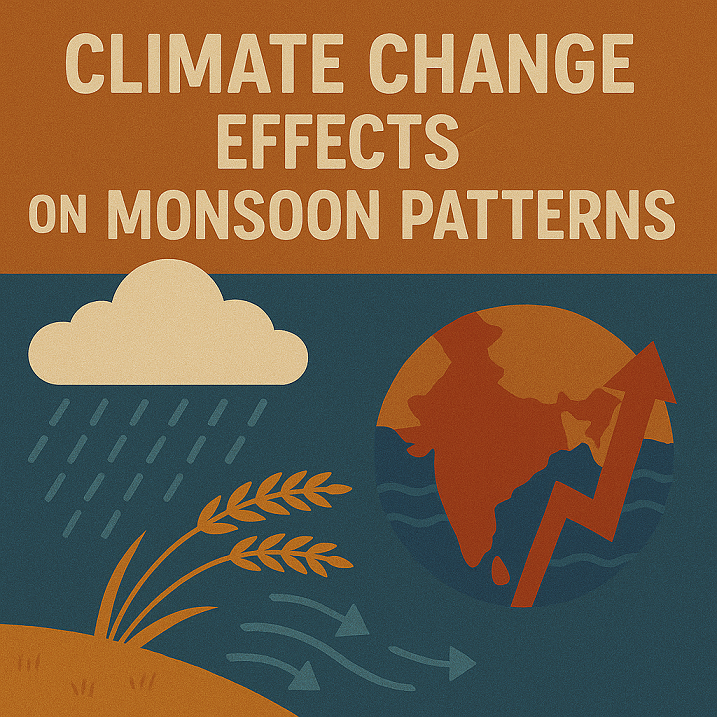Learn how climate change is disrupting monsoon patterns in the South China Sea and what that means for maritime industries, regional weather systems, and future oceanic operations.

Why Monsoons in the South China Sea Matter for Maritime and Climate Systems
The South China Sea (SCS) is more than just a hub of trade routes and territorial disputes. It is also one of Asia’s most critical climatic zones, where the seasonal rhythm of the monsoons drives fisheries, agriculture, shipping schedules, and ecological productivity. But as climate change accelerates, this monsoon rhythm is shifting in alarming ways.
Traditionally, the SCS region experiences two dominant monsoons: the Southwest Monsoon (May to September) and the Northeast Monsoon (November to March). These seasonal winds influence everything from rainfall patterns across Southeast Asia to typhoon formation, ocean circulation, and marine biological productivity. Disruptions in monsoon behavior now pose serious threats to regional stability, with impacts rippling from port logistics to food security and disaster preparedness.
Changing Monsoon Dynamics: What the Science Shows
Altered Rainfall and Wind Patterns
Recent data from the Intergovernmental Panel on Climate Change (IPCC) Sixth Assessment Report and the World Meteorological Organization (WMO) confirms that the SCS region is seeing delayed onset, shortened durations, and more erratic rainfall associated with monsoon systems. The Philippine Atmospheric, Geophysical and Astronomical Services Administration (PAGASA) and Vietnam’s National Center for Hydro-Meteorological Forecasting (NCHMF) both reported inconsistent rainfall in 2022 and 2023, with drier-than-normal early monsoons followed by sudden flooding.
This unpredictability poses direct challenges to coastal communities and maritime operations that depend on stable seasonal forecasts.
Intensification of Typhoons
A warmer atmosphere holds more moisture. Combined with rising sea surface temperatures in the SCS, this fuels the formation of more intense and wetter typhoons. A 2022 study in Nature Geoscience linked warming in the Western Pacific with the increased frequency of super typhoons affecting the SCS, including destructive events like Typhoon Rai (2021).
These storms are now forming earlier and persisting longer, often overlapping with transitional monsoon periods, creating chaotic weather patterns that increase risks for seafarers and coastal ports.
Shift in Monsoon Wind Strength
The strength of seasonal winds, particularly during the Southwest Monsoon, appears to be declining in some years and intensifying in others. According to research published in the Journal of Climate, this variability is connected to complex interactions between global greenhouse gas concentrations, ocean-atmosphere feedback loops, and shifts in the Indian Ocean Dipole (IOD) and El Niño-Southern Oscillation (ENSO).
For shipping and maritime trade, this results in irregular wind-assisted routes, unexpected sea-state changes, and higher operational uncertainties for navigation and scheduling.
Climate Drivers Behind the Change
Greenhouse Gas Emissions and Ocean Warming
The South China Sea has warmed by approximately 0.12°C per decade since 1950, according to data compiled by the Asia-Pacific Network for Global Change Research (APN). This is above the global average. Warmer seas directly alter evaporation rates, humidity profiles, and energy available for weather systems.
Melting Ice and Arctic Oscillations
Changing polar conditions, especially the retreat of Arctic sea ice, are influencing the jet stream and Hadley cell circulation. These broader atmospheric shifts can disrupt the pressure systems responsible for initiating and sustaining monsoons in the South China Sea.
Anthropogenic Land Use Change
Urbanization and deforestation across the SCS littoral states (China, Vietnam, Philippines, Malaysia) have altered local climate dynamics. Urban heat islands increase convection, while land degradation reduces moisture recycling – both of which weaken the natural triggers of seasonal rains.
Implications for Maritime Operations and Coastal Populations
Navigation and Safety
Erratic monsoon timing and the unpredictability of typhoons increase hazards for all vessels. According to data from Lloyd’s List Intelligence, insurance claims for weather-related maritime delays and damages have risen by over 30% in the past five years in the Western Pacific basin.
This forces shipping companies to reroute or delay voyages, incurring higher fuel costs and longer delivery times.
Fishing and Aquaculture
Traditional fishing calendars, long aligned with monsoon patterns, are now disrupted. Changing upwelling and current systems alter fish migration, leading to lower catches and pushing fishers further offshore. Reports from FAO and ICSF show declining yields in Vietnamese and Filipino coastal fisheries attributed to both overfishing and climate variability.
In aquaculture zones (e.g., Mekong Delta shrimp farms), unexpected salinity shifts and monsoon-induced flooding lead to disease outbreaks and economic losses.
Coastal Infrastructure and Ports
Ports in typhoon-prone areas like Hong Kong, Hai Phong, and Manila are increasingly investing in climate resilience: raised berths, mobile flood barriers, and better early warning systems. Still, downtime due to monsoon disruption is rising. BIMCO has recommended monsoon-resilient scheduling as part of its route optimization guidelines since 2021.
Additionally, ballast water exchange during erratic weather presents greater environmental and compliance risks under IMO’s Ballast Water Management Convention.
Real-World Case Studies
Haiyan and Yolanda: The Philippines Learns the Hard Way
Typhoon Haiyan (locally Yolanda) in 2013 marked a wake-up call. It hit during the transition between the Southwest and Northeast monsoons, catching communities off-guard. Over 6,000 people lost their lives. Subsequent monsoons saw disrupted rainfall patterns, delayed planting cycles, and prolonged dry spells. The government now integrates climate-modified monsoon forecasts into national disaster planning.
Mekong Delta: Squeezed Between Salt and Rain
Vietnam’s Mekong Delta relies on timely monsoons for rice and aquaculture. But climate change has brought both heavier rain and more intense dry seasons. A 2023 report from the World Bank revealed that over 60% of Mekong rice farmers had altered their planting schedules due to monsoon shifts. Meanwhile, saltwater intrusion during delayed rains damages freshwater farming systems.
Maritime Trade Corridors: Delays in the Strait
The Malacca and Singapore Straits, among the world’s busiest shipping lanes, now regularly experience storm surges and high waves tied to abnormal monsoon winds. In 2022, more than 120 ship arrivals were delayed during an extended monsoon surge, according to MarineTraffic.
Possible Solutions and Adaptation Strategies
Improved Forecasting and Early Warning Systems
Weather prediction models are evolving to account for climate-induced variability. Organizations like NOAA, ECMWF, and JMA now provide ensemble models that better anticipate monsoon anomalies.
National agencies are integrating real-time ocean data (buoys, satellites, and ships) into climate-aware monsoon models. Tools like Inmarsat’s FleetWeather help mariners adapt routes in real-time.
Maritime Policy and Climate Governance
Efforts to mainstream climate risk into maritime policy are gaining ground:
- IMO’s GHG Strategy (revised 2023) includes adaptation for ports and ship resilience
- ASEAN Working Group on Climate Change has prioritized climate-impacted maritime sectors in its 2025 roadmap
- UNCTAD’s Review of Maritime Transport (2023) highlights the need for port infrastructure climate proofing in tropical Asia
Education and Capacity Building
Port state authorities, maritime academies, and seafarer unions (e.g., ITF, The Nautical Institute) are pushing for updated training under IMO Model Courses. These cover climate literacy, emergency routing during volatile weather, and use of real-time satellite data.
Community-based adaptation is also critical. Coastal villages in Malaysia and the Philippines are experimenting with traditional and modern forecasting techniques (e.g., blending folklore with rainfall analytics) to predict monsoon shifts.
FAQ: Climate Change and Monsoons in the South China Sea
Why are monsoon patterns changing in the South China Sea?
Due to global warming, ocean temperature rise, altered atmospheric circulation, and land use changes. All these factors affect the timing, strength, and duration of monsoons.
How does this impact the maritime industry?
It increases weather-related delays, raises safety risks, disrupts fishing patterns, and affects port operations.
Are these changes permanent?
Some changes may be reversible with global emissions reductions. However, current projections suggest increasing volatility for at least the next few decades.
What can ports and shipping companies do?
Invest in climate-resilient infrastructure, integrate adaptive scheduling, and use advanced meteorological tools.
Are there global efforts addressing this issue?
Yes. The IMO, WMO, and UNFCCC are all collaborating on climate adaptation strategies for marine and coastal sectors.
How can individuals help?
Support sustainable policies, stay informed, reduce carbon footprints, and advocate for science-based climate action.
Conclusion: Navigating a Stormier Future
The monsoons have long been the lifeblood of the South China Sea. But climate change is rewriting the script. What was once predictable now swings wildly, from delayed rains to hyperactive typhoons. For maritime professionals, coastal communities, and policymakers alike, adaptation is no longer optional – it’s urgent.
Science, technology, and cross-border cooperation offer hope. But time is short. The challenge now is to move from warning signs to concrete action: smarter forecasting, resilient infrastructure, and climate-conscious governance.
The seas are changing. So must we.
References
- IPCC. (2023). Sixth Assessment Report. https://www.ipcc.ch/report/ar6/
- Nature Geoscience. (2022). Typhoon Trends in a Warming Pacific.
- PAGASA. (2023). Monsoon Climate Monitoring. https://www.pagasa.dost.gov.ph/
- World Meteorological Organization (WMO). (2023). State of the Global Climate. https://public.wmo.int
- Journal of Climate. (2023). Monsoon Variability in the South China Sea.
- MarineTraffic. (2022). Weather Delays in Maritime Corridors. https://www.marinetraffic.com
- FAO & ICSF. (2022). Climate Impact on Small-Scale Fisheries.
- World Bank. (2023). Mekong Climate Resilience Report.
- Lloyd’s List Intelligence. (2023). Shipping Claims Database. https://www.lloydslistintelligence.com
- UNCTAD. (2023). Review of Maritime Transport. https://unctad.org/webflyer/review-maritime-transport-2023
- ASEAN Working Group on Climate Change. (2023). Maritime and Coastal Adaptation Priorities. https://environment.asean.org
- IMO. (2023). Revised GHG Strategy. https://www.imo.org

